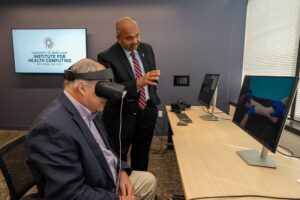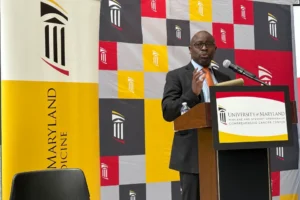UMD unveils Cole Field House’s newly renovated practice fields
Published 8/2/17 in the Diamondback
The new indoor football training facility at Cole Field House during a dedication ceremony on Wednesday, August 2, 2017. (Tom Hausman/The Diamondback)
University of Maryland and University of Maryland, Baltimore officials gathered at Cole Field House on Wednesday, unveiling its recently completed indoor practice fields to more than 450 people during its dedication ceremony.
University President Wallace Loh, flanked by six others — including this university’s football coach DJ Durkin, UMB President Jay Perman and this university’s athletic director Kevin Anderson — marked the completion of the project’s first phase, cutting a ceremonial red ribbon with a pair of oversized scissors.
“We’re here to celebrate a fearless innovation — the transformation of Cole Field House for the 21st century,” Loh told the crowd, wearing his signature Maryland flag-patterned bowtie. “ brings together not just athletics, but it’s integrated with neuroscience, research on the brain, brain recovery and larger human health.”
The $155 million project will also include two outdoor football fields, strength and conditioning training facilities, an orthopedic treatment center and a sports medicine research center. The second phase is expected to be completed in late 2018, with the facility opening in early 2019.
Durkin said it was hard to wipe the smile off his face when he first saw the facility.
“This building is a game-changer for us,” Durkin said. “It is a game-changer for us with our team, with our development, what we’ll be able to do on a day-to-day basis in here and recruiting — all of those things. You really can’t measure it.”
Several of this university’s football players agreed that the new facility would be instrumental in recruiting efforts, including wide receiver DJ Turner, who said the team had its first workout in the facility last week.
“ probably the best facility I’ve ever seen throughout my four years of high school when I was getting recruited,” Turner said. “Just being in there, you feel kind of like a different player.”
Defensive lineman Jesse Aniebonam said it was “crazy” to see the renovation come together.
“It’s going to elevate our program to the next level,” Aniebonam said. “I’ve seen other facilities, and I’ve seen ours, and by far the best I’ve ever seen.”
More than two-thirds of the funding has been raised already, Loh said. The project has brought in $57 million in private donations as of June, according to a university press release, and the state has committed $40 million, said Maryland Senate President Thomas V. Mike Miller. This facility is this university’s largest fundraising project to date, Loh said.
The state of Maryland provided an initial investment of $3 millionthrough the MPowering the State initiative, a collaboration between this university and UMB to boost interdisciplinary research programs. Kevin Plank, an alumnus of this university and Under Armour’s CEO, also donated $25 million to the effort.
Miller said the project would benefit more than just athletics at this university, noting that $61 million, or nearly 40 percent, of the total funds are devoted to academics.
The two campuses will collaborate to create “cutting-edge research” in genomics, sports medicine and brain science, in addition to providing athletic training through the Terrapin Performance Center and ambulatory care through Cole’s orthopedic center, said University System of Maryland Chancellor Robert Caret.
“ so many different pieces that are in some ways different but work together to make this the kind of facility that will be the elite facility, the only facility of its type in the country,” Caret said.
This project is a “showpiece of the best science and the best scientists coming together” who will provide solutions for some of the most urgent challenges of injury prevention and recovery, Perman said.
Perman noted that recent reports have linked degenerative brain disease to repeated head trauma athletes have sustained while playing football, among other sports. Research published last month in The New York Times examined 111 brains of former NFL players and found chronic traumatic encephalopathy in 110 of them.
“The headlines are scary,” Perman said. “But I’m glad they’ve gotten our attention … because the questions they raise are exactly the questions we’ll start answering here at Cole.
“We love our sports, but we love our athletes even more,” he continued. “And we have an obligation to them. We have an obligation to ensure they live healthy, happy lives, long after their playing days are over.”
Andrew Pollak, the University of Maryland School of Medicine in Baltimore’s orthopaedics department chair, said the facility’s initial research focus will be on concussions and their effects on everyone from college and high school athletes to “weekend warriors.”
The goal is to transform the way these types of injuries are approached, studied and treated, said Elizabeth Quinlan, this university’s Center for Sports Medicine, Health and Human Performance co-director.
“We’re going to have to figure out how to prevent concussions or manage concussions if football is going to have a future in this country,” Pollak said. “This is critical to that future.”
The facility will will benefit anyone who is physically active by researching other types of ailments, such as hip, knee and shoulder injuries, Pollak added.
Pollak said while there are facilities like Cole Field House around the country, they are not on the same scale as this project. With the facility’s research into health, human performance and neuroscience, Loh is confident it “will attract people.”
“Just like all these other facilities that we are building,” Loh told The Diamondback, “they’re attracting top-notch students and faculty.”




